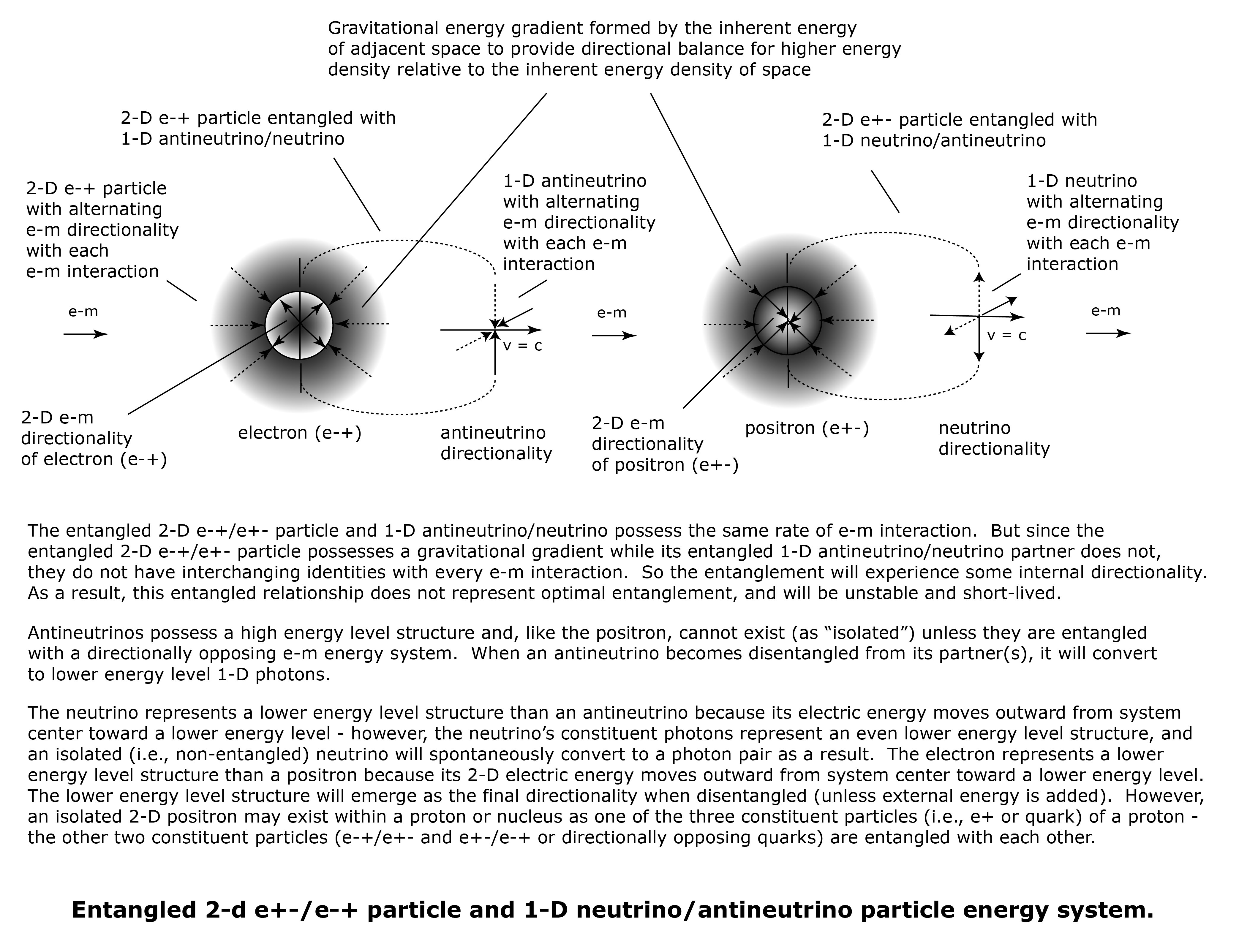There may be at least two ways that a 2-D e-+/e+- particle can become entangled with a 1-D antineutrino/neutrino:
- Within an atomic nucleus as part of the radioactive decay process, and
- Through disentanglement of a 2-D e-+/e+- particle pair when one of the partners interacts with a high energy 1-D photon that spontaneously converts to a 1-D antineutrino/neutrino as a result of that interaction.
Within an atomic nucleus:
Within a radioactive atomic nucleus, an electron (i.e., beta particle) may be emitted with an antineutron. In this model, this occurs when an e-+ particle becomes entangled with an antineutrino/neutrino and is emitted from the atomic nucleus during radioactive decay. The entangled pair becomes disentangled very shortly after emission from the atomic nucleus since they compose an unstable entanglement, and the e-+ particle converts to an electron because it has a lower energy level structure than a positron. The antineutrino/neutrino particle breaks down to its component photons since they are lower energy level structures.
When an entangled e-+ particle and an antineutrino/neutrino become disentangled soon after emission from an atomic nucleus, there are circumstances where the products are a positron and a neutrino. Since the positron consists of a higher energy level structure than that of an electron, the reason for its formation as a final product of disentanglement is a mystery. Maybe it occurs when its former entangled partner remains a neutrino rather than breaking down into its constituent photons. Perhaps the neutrino remaining at a higher energy level somehow allows the e+- particle to remain at a higher energy level as a positron instead of an electron. Or maybe the neutrino provides additional energy to the formation of a positron particle as it breaks down into a photon pair consisting of less energy as a result. (Or perhaps it could be due to exposure to a magnetic field during measurement.)
When 2-D e+-/e-+ partners become disentangled:
When a 2-D e+-/e-+ particle becomes disentangled from its 2-D e-+/e+- partner as a result of interaction with a high energy 1-D photon, it may become entangled with that photon – but as it does, the photon converts to a 1-D neutrino or anti-neutrino, a structure capable of simultaneously alternating e-m directionality, and therefore able to become entangled with a 2-D e-+/e+- particle.
An entangled 2-D e+-/e-+ particle and 1-D neutrino/anti-neutrino both consist of alternating e-m directionality with every e-m interaction, but since they possess different dimensionalities and are therefore not identical, they cannot interchange identities, and as a result, they do not possess optimal directional balance.
Do the entangled 2-D e+-/e-+ particle and 1-D neutrino/anti-neutrino experience each other as mirror images, existing next to each other, with no directionality, including spin, charge, time, and additional space between them from the instant of their creation? Since they possess different dimensionalities, the 2-D particle with a gravitational energy gradient (i.e., mass) and its 1-D partner with no gravitational energy gradient (i.e., massless), it is likely that they experience directionality between them. This type of entanglement is not optimal and likely quite unstable.
When a 2-D e+-/e-+ particle and its 1-D neutrino/anti-neutrino partner become disentangled, if they are “isolated” (not interacting with another energy system), the 2-D e+-/e-+ particle will convert to an electron and the neutrino/anti-neutrino will convert to a photon or photons (at the earliest opportunity) – because the electron possesses a lower energy level structure than a positron, and the photon possesses a lower energy level structure than a neutrino or anti-neutrino.

